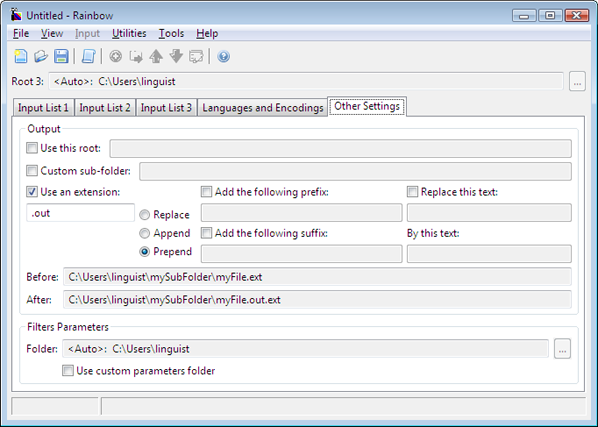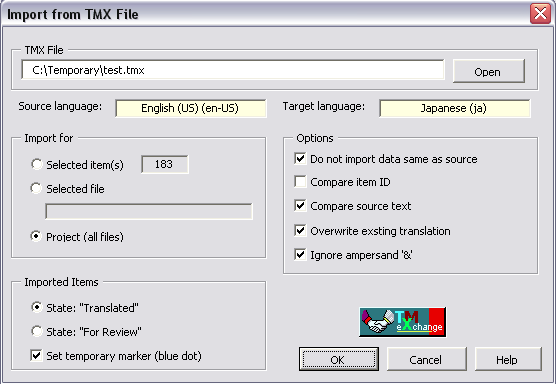

- #USE TMX FILES OMEGAT HOW TO#
- #USE TMX FILES OMEGAT CODE#
- #USE TMX FILES OMEGAT FREE#
#USE TMX FILES OMEGAT FREE#
Look at the "grow" heuristic in the slides.We focus on FREE translation memory tools. Is there some simple way (either heuristically or by modifying the model either one is fine) where weĬould break the independence assumption in Model 1 and allow theĪlignment of a word at position j to be influenced by the word at. How could we force cognates (for a language pair like French/English) to be aligned correctly? (Warning, this is a trick question). What is a short formula which determines the Viterbi alignment of a fixed sentence pair E and F? Suppose you are given Model 1 parameters estimated by someone else. Under what circumstances would we prefer that an English word e is unaligned (note that this question is about a gold standard alignment)?Īdvanced Questions about Model 1 (Optional). Under what conditions will an English word e in a particular sentence pair be left unaligned in the Viterbi alignment? What about a French word f?. Think about whether any of the entries in t will not be used. Can you think of a way to initialize that would involve setting some of the parameters in t(e|f) to zero or any other constant without affecting the results? Remember that if N is the number of English types, then t(e|f)=1/N for all e and f. How many entries does t(e|f) have after the initialization (line 1 of the pseudo-code)?. What is the alignment structure modeled by IBM Model 1 in the pseudo-code presented above? Is the structure symmetric with respect to English and Foreign?. You have to start with the t values on slide 41 to do this, and you apply them to just the pair of two word sentences on slide 41. Start by convincing yourself that the incredibly simple estimation you do by running the main loop of the pseudo-code once gives the same results as explicitly enumerating the alignments in slide 41 (the slide where we calculated counts by working on four alignment functions by explicitly enumerating each one). Turn in a short text answering these questions along with your source and target text files. What is this file for? How should you modify it if you switch language directions (translating your language to English)? How much support for segmenting and fuzzy matching is there in your language (see the OmegaT manual)? Compare this with support for segmentation and fuzzy mapping in English. IMPORTANT: look at the mytest-omegat.tmx file located in the main project directory and describe its contents. Select "generate translations" (the hotkey is control-D) to get OmegaT to output its database of translations to the target subdirectory. Use right click to get to "Replace translation with match". You should see a "fuzzy match" to the right. The first sentence should be an exact match. Add 3 new sentences, these should be similar to sentences two to four in the first file, change just one word per sentence. For the first sentence, take the same first English sentence as you used before (i.e., the first sentence in text1.txt). Go back to the source subdirectory of the project and create another text file "text2.txt". Check the file there to make sure that the output looks OK. The results of your work are stored in the "target" subdirectory, using the same filename. Select "generate translations" (the hotkey is control-D) to get OmegaT to output its database of translation to the target subdirectory. Click on the target part of each one, and enter the translation in your language. You should see the 5 sentences, which are queued up for translation. #USE TMX FILES OMEGAT HOW TO#
Make sure to use proper punctuation, OmegaT knows how to segment English sentences. Go to the main directory of the project, then the source subdirectory of the project and create a text file called "text1.txt" containing 5 sentences in English.Make a note of where the project was created (the path on disk).
#USE TMX FILES OMEGAT CODE#
Make the target language be the two letter code for your language.

Make the source language EN-US or EN-GB (depending on whether you prefer to write in American or British English).
Create a new project (see the "instant start" guide to OmegaT, Chapter 2 of the manual, you can find a direct link in Google), call the project "mytest" (without quotes). 
Second part - do a basic exercise and answer some basic questions about Model1 (and, optionally, some harder questions) Assignment 2 (OmegaT and IBM Model 1, no programming) Assignment 2 (OmegaT and IBM Model 1, no programming)įirst part - do a small translation job using OmegaT







 0 kommentar(er)
0 kommentar(er)
